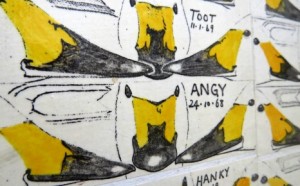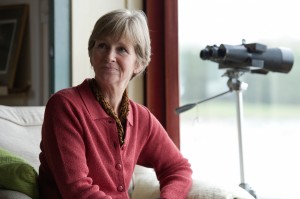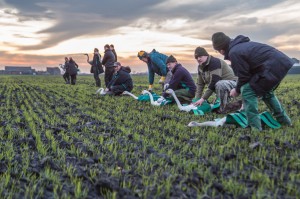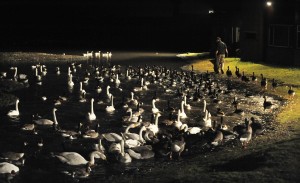Bewick’s swan 50th ‘swanniversary’
 One of the longest running animal research projects in the world passes the 50 year mark today.
One of the longest running animal research projects in the world passes the 50 year mark today.
The Wildfowl & Wetlands Trust’s Bewick’s swan study is unique in the world as it’s the only study in which researchers recognise individual birds by their faces, rather than by ringing.
The personal relationship between researchers and birds has delighted millions of visitors to WWT’s Slimbridge and Welney Wetland Centres and helped to pass legislation across Europe to protect this declining species.
- The study started on 11 February 1964 when the conservationist Sir Peter Scott, painting swans outside his window in Slimbridge, noticed each had a unique bill pattern.
- His young daughter Dafila helped to paint and name dozens more swans. As she grew up, she formalised her love for the birds into a scientific research project.
- After Dafila, each new WWT researcher has had to spend a winter learning the swans’ faces before taking over the reins. More than 9,000 individual swans have now been identified.
- Researchers have logged the gripping stories of generations of Bewick’s swans: like how Casino lived to 27 years old and produced 34 cygnets; how Sarindi and Saruni got ‘divorced’ but now both happily share the lake at Slimbridge with their new partners; or how Derek – named after an invaluable volunteer – disappeared for five years before mysteriously re-appearing.
- The study has spawned sister studies in five other countries. Together they’ve produced long-term data on how weather, climate and disturbance have affected the swans’ breeding and survival rates, their choice of wintering sites and social dynamics.
- The study has led to an internationally binding Species Action Plan to maintain numbers, and statutory protection of key breeding sites in Russia and wintering sites in the UK - largely in and around the sanctuary of WWT Wetland Centres.
- And the work continues! This winter we’re fitting transmitters to a small number of birds to track their exact flight route and height across the North Sea, to inform plans for offshore wind farms.
- Bewick’s swans are very shy of humans. But at WWT Slimbridge and Welney Wetland Centres, they’ve learned to trust WWT staff and volunteers. Every evening the wild swans come into feed just feet away from visitors behind glass.
 Dafila Scott said:
Dafila Scott said:
“My father would have been very proud to see the scientific research still going strong, 50 years after we first started painting individual swans and giving them names.
“The study is everything my father set up WWT to be. Visitors and researchers watch the swans together, experiencing the magic of being close to them and following their loves, power struggles and tragedies from one generation to the next.
“Through this understanding, we’ve produced decades of high quality research which has led to statutory protections for important wetlands and hope for the species’ future.”

The Bewick’s swan is the smallest of the northern migratory swan species. It breeds in Arctic Russia and three populations head south every winter to Central and Eastern Asia and to NW Europe to find food and unfrozen waters. The European population rose to a peak of 29,000 in the mid-nineties but has declined rapidly in recent years – by around a third.
WWT research has identified long-term threats to the Bewick’s swan include habitat loss and climate change which can displace them and disrupt food cycles. While this is carefully monitored, immediate action focuses on risks to individual birds who face collisions with power lines and wind turbines, illegal or accidental shooting and lead poisoning and on identifying more specific reasons for the population decline.
Visitors to WWT Slimbridge and Welney Wetland Centres can watch daily feeds of wild Bewick’s swans from the warmth and comfort of heated hides. In-hide computers let you find out which swans you’re looking and all about which family they’re part of.
 There are similar daily swan feeds at WWT Martin Mere and Caerlaverock where you can get close to the Bewick’s swan’s close relative, the whooper swan. You can also see Bewick’s swans in the collections at WWT Arundel, Llanelli and London Wetland Centres. Or if you can’t get to a WWT Wetland Centre, there’s lots of great information including video, a Bewick’s swan diary and even banners for your Facebook page at www.wwt.org.uk/swans
There are similar daily swan feeds at WWT Martin Mere and Caerlaverock where you can get close to the Bewick’s swan’s close relative, the whooper swan. You can also see Bewick’s swans in the collections at WWT Arundel, Llanelli and London Wetland Centres. Or if you can’t get to a WWT Wetland Centre, there’s lots of great information including video, a Bewick’s swan diary and even banners for your Facebook page at www.wwt.org.uk/swans

